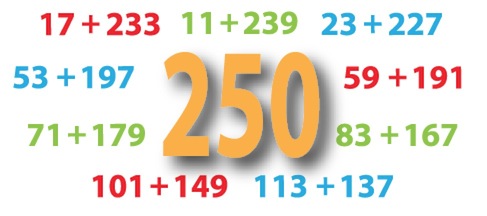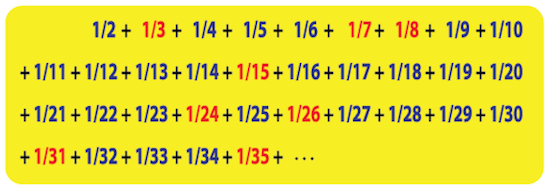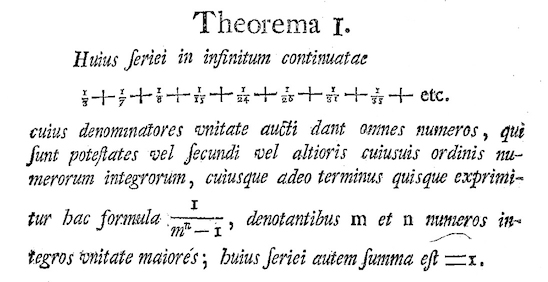Christian Goldbach's magic sum
Burkard Polster and Marty Ross
The Age, 8 September 2014

This week we're pleased to present The Age's 250th Maths Masters column. Since 2007 we've covered plenty of territory and your Maths Masters are frequently asked whether we're running out of ideas. The answer is a resounding "Yes": next week's topic is Snakes and Ladders and that's about it. Then we'll just keep banging on about Tony Abbott and Australian mathematics education until our readers run us out of town.
However we still have one meaty mathematical topic left. This week we acknowledge another milestone, the 250th anniversary of the death of German mathematician Christian Goldbach.
Goldbach may not have been one of the great mathematicians but he was no slouch, and he had the good sense to correspond with a number of the greats: Gottfried Leibniz, lots of Bernoullis and, most famously, the mega-great Leonhard Euler. It is largely for this correspondence that Goldbach is now remembered, in particular for a 1742 letter to Euler on natural numbers (positive whole numbers) and what is now famously known as Goldbach's conjecture.
Goldbach's conjecture is tantalising because it is so easy to understand. It is the simple statement that any even natural number greater than 2 can be written as the sum of two prime numbers. So, for example 4 = 2 + 2, 6 = 3 + 3, 8 = 3 + 5 and so on, hopefully to infinity. (Actually Goldbach, along with many of his contemporaries, considered 1 to be a prime number, and so 2 = 1 + 1 can also be written as the sum of two "primes".)
Is Goldbach's conjecture true? No one knows, though Euler definitely believed so. He wrote that the conjecture was "an entirely certain theorem in spite of that I am not able to demonstrate it". Mathematicians today are just as confident, but why? After all, 270 years is a long time to be waiting for a proof.
Suppose we plan to write each of the even numbers below 1,000,000 as a sum of two prime numbers. The first question is how many primes do we have at our disposal, and the answer is over 70,000. But that means if we consider the different ways of summing two of these primes then we have over two billion pairs. That's a lot of pairs, enough for each even number to be written in 4000 different ways.
That's by no means a proof of Goldbach's conjecture, even for our limited range: some even numbers may simply be unlucky and be missed altogether. However any unlucky even number must be huge: Goldbach's conjecture has been checked by computer up to 4,000,000,000,000,000,000. Moreover, similar statistical estimates for the frequency of primes all the way to infinity provide strong circumstantial evidence that Goldbach's conjecture is true. As for Euler, he didn't have nearly as much data or as much knowledge as modern mathematicians, but he knew a lot and Euler had an unsurpassed intuition for numbers.
It is impossible to predict whether Goldbach's conjecture will be proved next year or not for centuries. However there has been some remarkable progress. It is known that every even number can be written as a sum of at most six primes. It also appears that a related conjecture of Goldbach's was proved last year; this would imply that every even number can be written as a sum of four primes. (The comic xkcd provides a convenient summary of Goldbach's conjectures.)
Anyway, while we patiently wait for the definitive proof we can appreciate Goldbach's conjecture as cultural icon. The conjecture has appeared in Futurama, it was a motive for murder in a TV mystery, it played a feature role in a movie, Jimmy Stewart pondered it, and it was the central theme of a popular novel.
There's no end to the amount we could write about Goldbach's conjecture. However, we want to turn our attention to another gift of Goldbach's and Euler's correspondence. In a (now lost) letter to Euler, Goldbach discussed a remarkable infinite sum. This sum, which we'll call Gold, begins
Gold = 1/3 + 1/7 + 1/8 + 1/15 + 1/24 + 1/26 + 1/31 + 1/35 + 1/48 + ...
Hmm. So, each term is the reciprocal of a natural number, but what's the pattern? The clue is to add 1 to each denominator, producing the numbers 4, 8, 9, 16, 25, 27, 32, 36, 49. So, every denominator is 1 less than a power: 22, 23, 32, 42 and so on. Goldbach's infinite sum includes the fractions resulting from all such powers (without repeating any fraction).
But how can we calculate such a sum, and why would we think it sums to anything interesting? Well, the only real answer to the second question is "Think like Euler". At the beginning of one of his amazing papers, Euler presents a remarkable method of calculating Gold.
Let's start with the sum of all the reciprocals:
Total = 1/2 + 1/3 + 1/4 + 1/5 + 1/6 ...
We first want to get a sense of the value of Total. The brilliant idea is to regroup the sum into infinitely many infinite sums, as follows:
Total = (1/2 + 1/4 + 1/8 + ... )
+ (1/3 + 1/9 + 1/27 + ... )
+ (1/5 + 1/25 + 1/125 + ... )
+ (1/6 + 1/36 + 1/216 + ... )
+ (1/7 + 1/49 + 1/343 + ... )
+ (1/10 + 1/100 + 1/1000 + ... )
+ ....
So, in each bracket the denominators are successive powers, with the first denominator not a power. (It takes a little thought to see that each fraction occuring in Total still appears exactly once.) And the point is, each individual bracket can be easily summed.
The first bracket, 1/2 + 1/4 + 1/8 + ..., is probably most familiar. It is not difficult to believe that it sums to 1, and this can easily be proved with a little pretty trickery.
In fact, every bracket is what is known as a geometric series, and all the sums can be calculated by the same trick. The sums are 1, 1/2, 1/4, 1/5, 1/6, 1/9, and so on. So,
Total = 1 + 1/2 + 1/4 + 1/5 + 1/6 + 1/9 + ...

That is, Total sums to 1 more than all the reciprocals that do not appear in the sum Gold. Adding Gold to both sides, we find
Total + Gold = 1 + Total.
Finally, subtracting Total from both sides, we conclude that Gold = 1. Amazing.

Even more amazing, the proof as Euler presented it is complete nonsense. And, morely more amazing, though Euler's proof is nonsense it is in fact true that Goldbach's sum is equal to 1. This is now known as the Euler-Goldbach theorem.
What's wrong with Euler's proof? The problem is that Total sums to infinity, which means that Euler has simply proved that Gold + infinity = 1 + infinity. Euler may then blithely subtract infinity from both sides, however it's the kind of mathematical move that would normally attract a big red cross on your Year 9 homework.
Euler's calculation is in the same spirit as his "proof" that 1 + 2 + 3 + 4 + ... = -1/12, which was featured recently in a very silly video. The difference is, whereas Euler's answer for the sum of natural numbers is fundamentally not true, his calculation of Gold above can be performed more carefully, in a completely justifiable way. (A fascinating article on the history and proofs of the Euler-Goldbach theorem can be found here.)
Euler is famous for such magic tricks and Goldbach tends to be represented as the pedestrian one, as merely Euler's sounding board. Undoubtedly Euler was the infinitely greater mathematician but Goldbach shouldn't be underestimated. In fact it seems that the above calculation of Gold is due to the "Celebrated Master" Goldbach, not Euler; at least Euler claims as much in his paper.
Perhaps Goldbach was such a valued muse because he was also able to think magically, in the spirit of Euler himself.
Burkard Polster teaches mathematics at Monash and is the university's resident mathemagician, mathematical juggler, origami expert, bubble-master, shoelace charmer, and Count von Count impersonator.
Marty Ross is a mathematical nomad. His hobby is helping Barbie smash calculators and iPads with a hammer.
Copyright 2004-∞ ![]() All rights reserved.
All rights reserved.